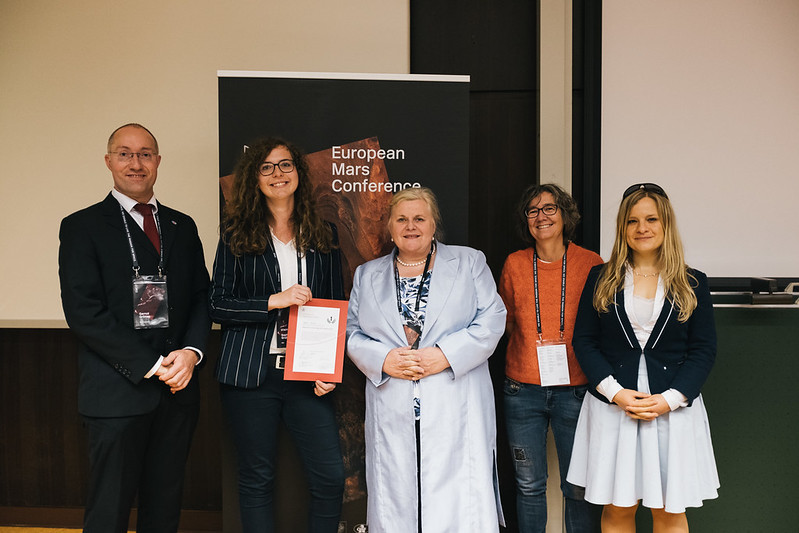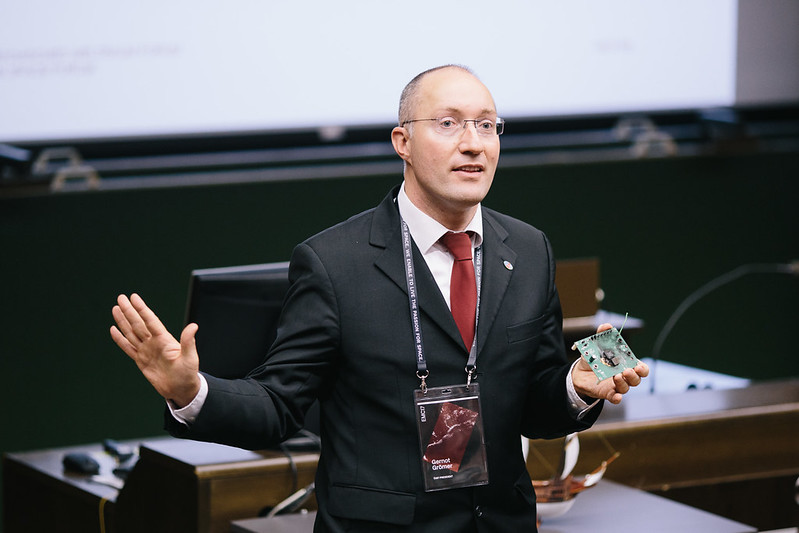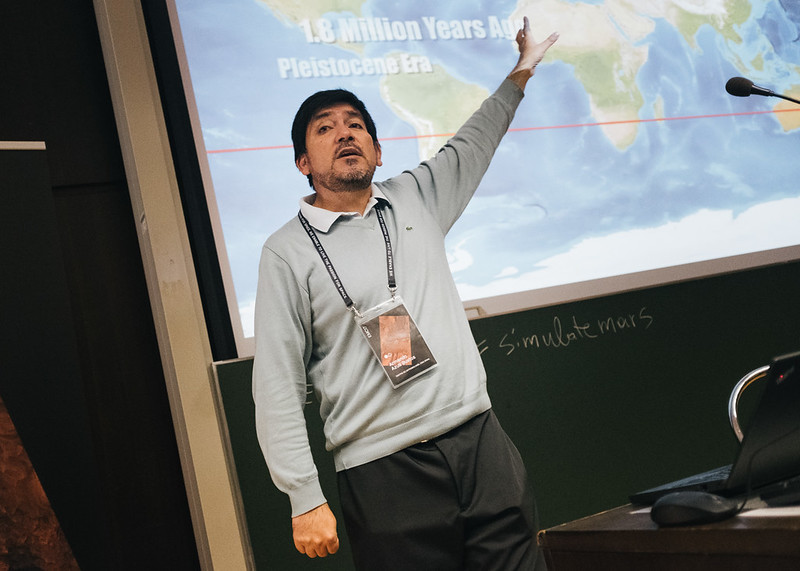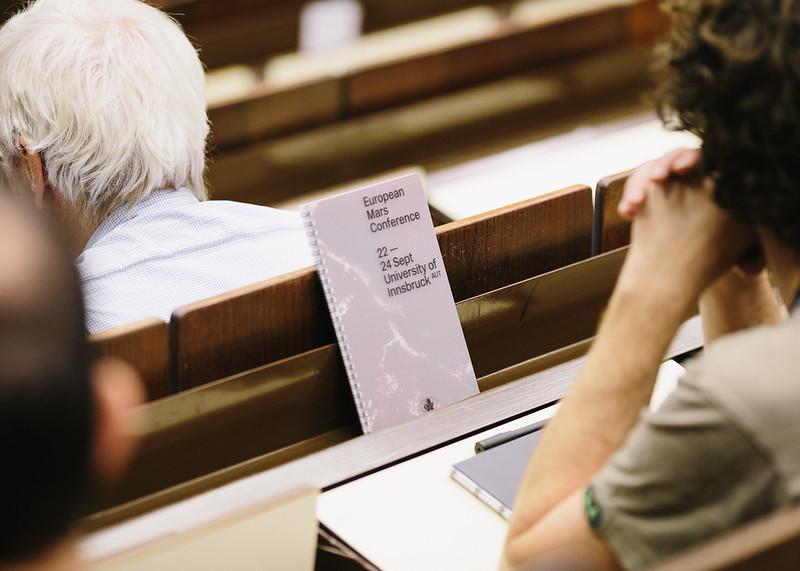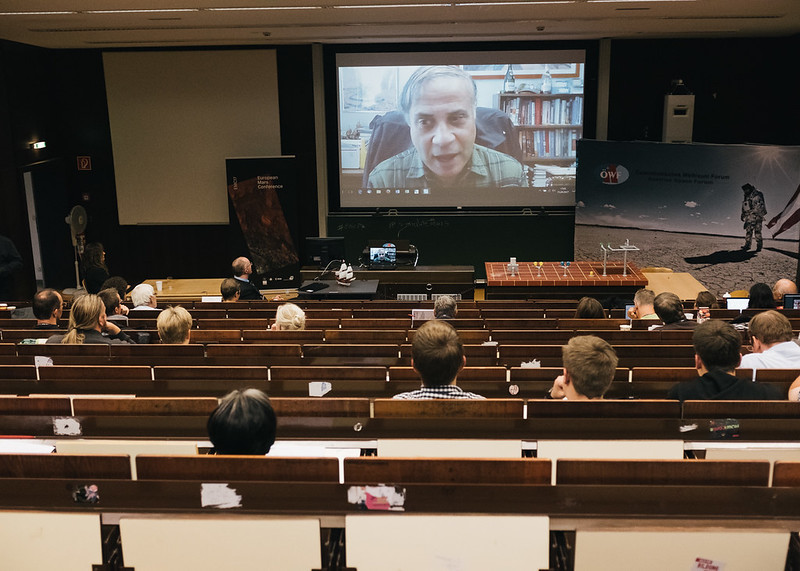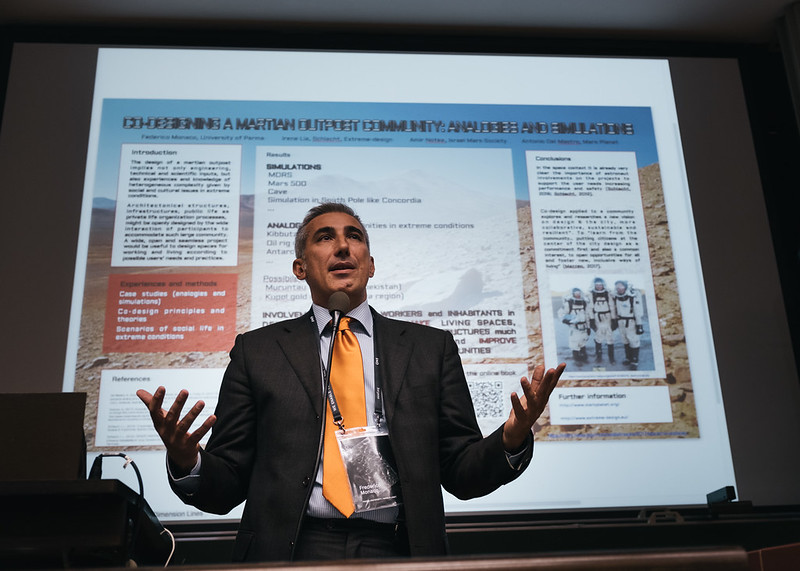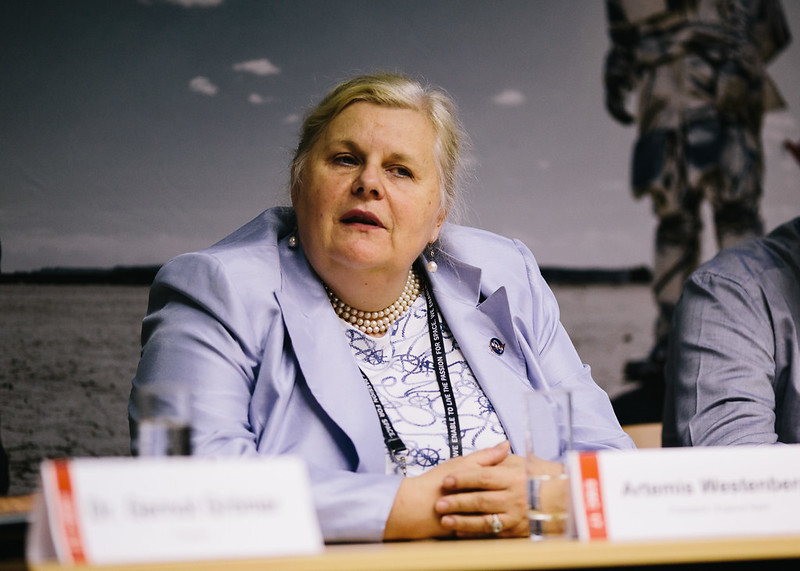2017
This was the European Mars Conference 2017

For the first time, the European Mars Conference (EMC) took place in Innsbruck, Austria (22-24 September 2017). Together with the University of Innsbruck, we had the pleasure to host about 60 participants from all over Europe.
Find all conference photos on flickr.com/oewf
Student Forum on Friday, 22 Sep 2017
Another first was the EMC17 student forum on Friday. Students between 15-25 years had the opportunity to present in 15min oral presentations their scientific work on Mars and space exploration. Topics can ranged from 3D printing, settling in Martian caves, copters, propellers, physics of ice sublimation in caves on Mars and spacesuit design.
Special mention to Teresa Treichl, Astrid Pflügler and Patricia Friedl for their concept for settling caves on Mars! Congratulations! #EMC17 pic.twitter.com/e38reuYT2X
— Austr. Space Forum (@oewf) September 22, 2017
Artemis Westenberg from the jury pointed out that the student forum covered very diverse topics, which is necessary if you want to send humans to Mars.
Silvia Prock from the University of Innsbruck said that is was very difficult as a jury to choose one winner. All of the students are winners.
Finally Sophie Gruber was announced as winner of the student contest, for her presentation “Stability of Martian subsurface ice in caves”. Congratulations!
Bright minds, brilliant ideas! Sophie Gruber wins, runner-ups Arno Passeron and Thibault Paris! Congrats to you all! ? #EMC17 pic.twitter.com/9lMqAv8xDS
— Austr. Space Forum (@oewf) September 22, 2017
Photo: Sophie Gruber (2nd from left) with the EMC17 student forum jury. (c) OeWF (Florian Voggeneder)
Opening ceremony
Gernot Grömer, EMC host opened the conference with a lecture on the OeWF Mars Analog Missions. All started back in 2003 when Groemer was selected as crew member of Crew 11 at the Mars Desert Research Station (MDRS) in Utah. The first OeWF Mars Analog Mission followed in 2006 with an all-Austrian MDRS crew “AustroMars”, which led then to implementation of PolAres program and development of the Aouda spacesuit simulator. In 2009 something small and bad happened, which was a true game changer in how we work – Safety must stand above all other interests.
Photo: Gernot Groemer with small device who changed our thinking. (c) OeWF (Florian Voggeneder)
This was a very important lesson for us, but improved the quality of our work and led to 11 successful Mars Analog field campaigns.
Reflect on today's experience visiting #EMC17: outstanding students work, enthusiastic people and vision for a biplanetary civilization.
— Jens W. Klein (@yenzenz) September 22, 2017
Saturday 23 September 2017
Technical session 1: Life without water and AMADEE-18 Mars simulation
The morning started with a keynote address on Astrobiology by Armando Azua-Bustos from the Centro de Astrobiología in Spain. He explained us why the Atacama Desert in Chile is an extremely dry place. Therefore, it makes sense to look for life in this desert as water is extremely rare. Moreover, this makes it a perfect Mars Analog. As an example, Mr. Azua-Bustos showed us an alga living on spider-nets in the Atacama, to use the morning dew on the net.
Can life on Earth or Mars be active without water? We may need to expand our definition of "life" #EMC17 pic.twitter.com/CHajr8nyPz
— Tricia L Larose, PhD (@TricLarose) September 23, 2017
The key take away from this fantastic lecture: Life adapts. If we want to look for life on Mars, we might should consider looking for life in a different way than we know if from Earth.
Can life on Earth or Mars be active without water? We may need to expand our definition of "life" #EMC17 pic.twitter.com/CHajr8nyPz
— Tricia L Larose, PhD (@TricLarose) September 23, 2017
Photo: Armando Azua-Bustos (c) OeWF (Florian Voggender)
Summing up the morning session, Gernot Grömer introduced the “Next Big One” -> AMADEE-18. In February 2018, the Austrian Space Forum will conduct a 4-week Mars Simulation in the Sultanate of Oman. The mission framework also includes several innovative concepts, such as the Analog Mission Performance (AMP) metric – to measure the success of Mars simulations from different aspects as well as it can serve as a benchmarking tool for analog research.
How can you measure success of #simulateMars missions? With #AMP metric of course. If you do Mars sims, consider using this metric #emc17 pic.twitter.com/NjxELk2ZyM
— Olivia Haider (@olidax) September 23, 2017
Technical Session 2: Space Ethics, Social Media, Space Weather in Virtual Reality
#EMC17 Tech session 2: #SpaceEthics @TricLarose #SocialMedia #SciCom @olidax #VirtualReality #SpaceWeather @Marssociety (c) @voggeneder ) pic.twitter.com/KLoGnWHNyD
— Austr. Space Forum (@oewf) September 23, 2017
Tricia Larose challenged the audience with ethical questions about the human journey to Mars. Although it was a controversial topic, Tricia Larose pointed out various aspects of crewed space flight we would have to consider before thinking about going to Mars. Speaking about cloning, she left the audience with a sentence, which for sure was keeping some minds busy: We cannot only make people, we can also make parts for people.
Technical Session 2: @triclarose talking about #SpaceEthics – an engaging lecture about an important topic in Mars exploration. #EMC17
— Austr. Space Forum (@oewf) September 23, 2017
Can we colonize another planet while destroying our planet? #FoodForThought with @triclarose at #emc17
— Austr. Space Forum (@oewf) September 23, 2017
OeWF Social Media Team Lead Olivia Haider then summarized the best practices and lessons learned from previous #simulateMars missions and explained that social media is a perfect science communication tool, as you can reach more than 10,000 people with one tweet if you write in a precise and understandable way. She invited the audience to get active on Social Media and promote #simulateMars as important step to prepare humans for Mars.
Science and social media – a perfect match. We agree @olidax ! #EMC17 pic.twitter.com/lBx1YUSW8d
— Tricia L Larose, PhD (@TricLarose) September 23, 2017
thank you so much @olidax for your great talk at #emc17 – social media is often overlooked as an important science communication tool!
— laura (@citronslemons) September 23, 2017
Antonio del Mastro then concluded the 2nd tech session with a concept to integrate space weather forecast into their virtual reality mars station “Mars City”
New treadmill from our friends @Marssociety looks fantastic. Looking fwd. to use it for #Amadee18 #emc17 pic.twitter.com/K1GZmNXxA6
— Olivia Haider (@olidax) September 23, 2017
Effects of radiation include many health problems, we need to make sure to protect ourselves well in Mars exploration! #emc17 pic.twitter.com/bbp6cOyPq5
— Austr. Space Forum (@oewf) September 23, 2017
Photo: Audience (c) OeWF (Florian Voggender)
Technical Session 3: Innovative rover concepts & physics of ice sublimation
Innovative rover #1: Tibor Pacher from PuliSpace team introduce us to their rover, who works with wags instead of wheels (wags stand for wheels & legs). PuliSpace team came to life with the Google Lunar XPrize about 7 years ago. In 2013 they went with us to #simulateMars in Morocco to proof that the rover can move on rough terrain and moreover can be successfully controlled by a Mission Control Center in Budapest. The biggest challenge came later in 2013 when they went to Mauna Key, Hawaii, were the nearly lost the rover. Despite PuliSpace is not within the final 5 within GLXP, they continue to work on the rover to bring a piece of Hungary to the Moon.
Preparing a lunar rover in the framework of analog planetary research – great start to tech session 3 w Tibor Pacher! #emc17 @pulispace pic.twitter.com/2m32zbdvQW
— Austr. Space Forum (@oewf) September 23, 2017
I like Rovers ❤ #EMC17 #simulatemars pic.twitter.com/Z1dJLLqxWc
— Torben Baumgartner (@Toalba2) September 23, 2017
Innovative rover #2: Łukasz Wiśniewski then introduced us to HOPTER, a hopping robot concept. HOPTER is an example of a low mass (10 kg) underactuated robot, who can do jumps up to 3-4 m.
Very intriguing hopping rover concept now being presented by Łukasz Wiśniewski! Read more about it here: https://t.co/4EEtADoot5 #emc17
— Austr. Space Forum (@oewf) September 23, 2017
The session was closed by yesterday’s student contest winner Sophie Gruber on “Stability of Martian subsurface ice caves”.
What an inspiring talk by Sophie! On to #Mars! #emc17 #simulatemars pic.twitter.com/ABsusSvrSj
— Austr. Space Forum (@oewf) September 23, 2017
Technical session 4: Space Safety, PMAS & keynote lecture by Robert Zubrin
Jürgen Herholz from the German Mars Society focused in his talk on how to ensure human safety in spaceflight and mentioned also recent example of how space hardware can fail & bring humans in danger (e.g. spacesuit incident of Luca Parmitano were he nearly drowned). To ensure safety of humans for Mars its necessary to adapt design and documentation with provision of redundancies, oversizing, inspections & much more.
Humans are just as much part of spaceflight as hardware – how does ensuring their safety impact design?Tech sesh 5 w/ Jürgen Herholz! #emc17 pic.twitter.com/hQmgpyQY8I
— Austr. Space Forum (@oewf) September 23, 2017
The Poland Mars Analog Simulation (PMAS) who was recently conducted in Pila and Torun in Poland was then summarized by PMAS flight director Reinhard Tlustos. Six analogue astronauts conducted experiments during 2-weeks in a newly habitat – the Modular Analogue Research Station (M.A.R.S.) provided by Space Garden Company. Fun fact: The same company who built the M.A.R.S habitat build the habitat for the movie “The Martian”.
Reinhard Tlustos now giving an introduction to PMAS! #emc17 @AstroKitsune pic.twitter.com/dqGedhnTRc
— Austr. Space Forum (@oewf) September 23, 2017
Robert Zubrin founder and president of The Mars Society concluded the day with his keynote lecture via Skype.
He also challenged us with some interesting hypothesis, as he thinks that SpaceX like companies will be established soon in Europe, India and China. The audience doubted this, but he mentioned Virgin Galactic as European example.
Besides he pointed out his disregard concerning the Curiosity landing side. Why did we not send this expensive rover not to an interesting part on Mars, were water is supposed? There are too many rules for going to Mars.
Closing the #EMC17 day 02 with keynote of @TheMarsSociety founder & president @robert_zubrin #GYATM pic.twitter.com/D20zMcEns3
— Olivia Haider (@olidax) September 23, 2017
Photo: Robert Zubrin via live link (c) OeWF (Florian Voggender)
Sunday Sep 24 Sep 2017
Technical Session 5 & 6: ExoMars, Life on Mars, Mars Balloon
Focus of #Mars2020 more on doing science in good outcrops and less on moving around to find new sites – Jorge Vago at #emc17
— Austr. Space Forum (@oewf) September 24, 2017
Jorge Vago, project scientist of the European ExoMars waked us up with the newest insights of the mission. ExoMars rover is a little bit smaller than Curiosity (300 kg vs. 900 kg), but equipped with the most expensive experiment ESA ever built the MOMA (Mars Organics Molecule Analyser). This experiment will have a key role in detecting life.
#MOMA on board of @ESA_ExoMars is most expensive & largest instrument. Plays a key role in detection life -> https://t.co/YLbkwlBt26 #EMC17
— Olivia Haider (@olidax) September 24, 2017
He also pointed out that getting the right side to drill is important as it takes several days to conduct a drill.
“The drill is an exercise in patience”
@esa_exomars may be first rover to land in a place on Mars that is older than 3.6 billion years – a unique chance for new findings. #emc17
— Austr. Space Forum (@oewf) September 24, 2017
Pierre Brisson from the Mars Society Switzerland continued with an intriguing topic: “Exploring Mars to know more about the process of leading to life”. Is it possible that on Mars complex organic molecules developed? The answer to this question is to go there and look for it. Brisson also criticize that rules like from COSPAR (Committee of Space Research) prevents us from sending rover & humans to the really interesting sites on Mars.
Exploring life on Mars with Pierre Brisson from the Mars Society Switzerland! #EMC17 pic.twitter.com/yFlI5AIpCL
— Austr. Space Forum (@oewf) September 24, 2017
An update on the flag ship project “Miriam-2” of the German Mars Society was giving then by Tanja Lehmann. In their last parabolic flight campaign in 2015 they discovered some issues with deployment mechanism and are currently improving it to test it again in the next ESA parabolic flight campaign.
@MarsSociety_De Board member Tanja Lehmann talks about the #MIRIAM2 #ballute parabolic flight #EMC17 @oewf @uniinnsbruck pic.twitter.com/lAHHNO8yqL
— Mars Society (D) (@MarsSociety_De) September 24, 2017
A different approach in designing a Martian outpost presented Federico Monaco from the University of Parma. He and his team suggest a Co-design approach to involve people outside the space community similar to what citizen-science organisation are doing. Very interesting approach.
#emc17 co-designing a Martian community is also about connecting design to user experience says F. Monaco pic.twitter.com/fldEWq1Mrf
— Olivia Haider (@olidax) September 24, 2017
Photo: Co-Designing a Martian Community (c) OeWF (Florian Voggender)
Artemis Westenberg, co-founder of Explore Mars concluded the morning session with a very interesting talk on policy initiatives of Explore Mars and how the “Human To Mars” summit was born. Moreover, she pointed out that we need to get in the process of how NASA gets money (via US congress) and ensure that Mars is part of this money.
Great european analogy for Earth-Mars size comparison by @Artemis_on_Mars from @ExploreMars #emc17 pic.twitter.com/GhrvcPurje
— Olivia Haider (@olidax) September 24, 2017
#EMC17 Great talk of @Artemis_on_Mars on policy initiative of @ExploreMars. Impressive work they are doing in US. (c) (@voggeneder ) pic.twitter.com/gIKIDdvev5
— Austr. Space Forum (@oewf) September 24, 2017
The EMC17 then was concluded with an interesting panel discussion on: “Going Red: Mars exploration, space advocacy, citizen science and policy as allies or adversaries?” Panelist Gernot Grömer, Artemis Westenberg and Lukasz Wilczyński, discussed different aspects of how get people & politicians interested in sending humans to Mars.
"Don't stop! Sooner or later, you will know that you're right." – Lukasz Wilczyński at #emc17 panel discussion.
— Austr. Space Forum (@oewf) September 24, 2017
"There's always something your opponent wants-if you can find it, you can sell anything,because they're winning too."@artemis_on_mars #emc17
— Austr. Space Forum (@oewf) September 24, 2017
"We need to show what the next phase is – people will start to understand!" Lukasz Wilczyński #emc17
— Austr. Space Forum (@oewf) September 24, 2017
"WE humans are going to Mars, not just some geeks!" –@Artemis_on_Mars #emc17 ?
— Austr. Space Forum (@oewf) September 24, 2017
@Artemis_on_mars "I want to find a new article on living in space every week in mainstream media." #emc17
— Austr. Space Forum (@oewf) September 24, 2017
"Humans are a narrative-based society. It's about this voyage, this story we will one day share with our grandchildren."- G. Grömer #emc17
— Austr. Space Forum (@oewf) September 24, 2017
Photo: Panelist Artemis Westenberg (c) OeWF (Florian Voggender)
A big thank you goes to all the volunteers who helped to make this European Mars Conference possible.
Next year Mars Society Switzerland will host the conference. I hope to see many of you there.
If you want to know, what you get learn from such a conference, then check out these tweets ?
Lesson 1 learned at #emc17: youngsters rocks! 3 14yo young women inspired all with their project and earned a honourable special mention.
— Jens W. Klein (@yenzenz) September 24, 2017
L.2 learned at #emc17: Analog missions are trainings for future real. They are initiated by NGOs like @oewf and not ESA/NASA/… themselfes
— Jens W. Klein (@yenzenz) September 24, 2017
L.3 learned at #emc17: We Humans can go to Mars. We need to work hard & spend money on it. It will evolves our civilization.
— Jens W. Klein (@yenzenz) September 24, 2017
L.4 learned at #emc17: The community behind these efforts is open minded, focused, diverse & passionate. Science is one driver under others
— Jens W. Klein (@yenzenz) September 24, 2017
Find all conference photos on flickr.com/oewf
Author: Olivia Haider
- Tagged: EMC17, European Mars Conference, Innsbruck, MarsSociety, simulateMars
Events
Blog categories
- AMADEE-15 Simulation (13)
- AMADEE-18 (19)
- AMADEE-20 (21)
- AMADEE-24 (22)
- Aouda Spacesuit Simulator (67)
- ASE 2016 (9)
- Book tips (2)
- Events (32)
- Expeditions/Simulations (82)
- Flight projects (13)
- Guest blogs (14)
- Internships at the OeWF (57)
- OeWF internal (0)
- OeWF News (377)
- Phileas rover (21)
- Press Releases (41)
- Research/Projects (130)
- Serenity spacesuit (3)
- WBA 2025 (2)
- World Space Week (25)

